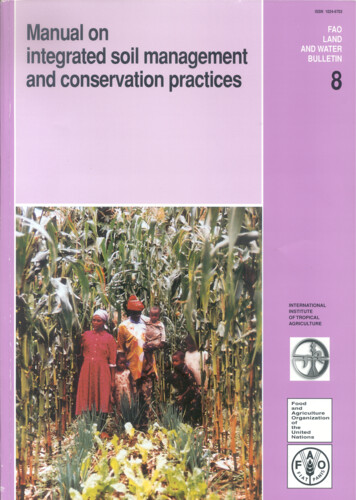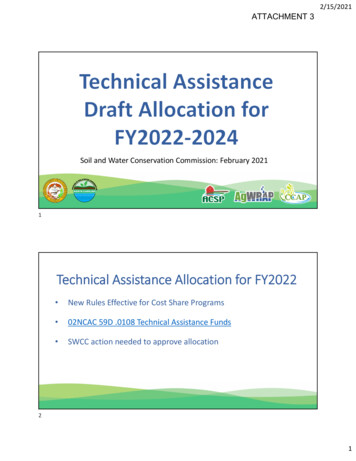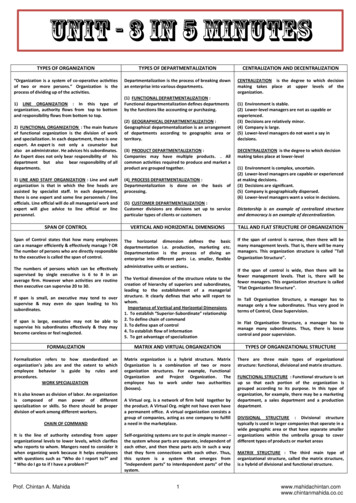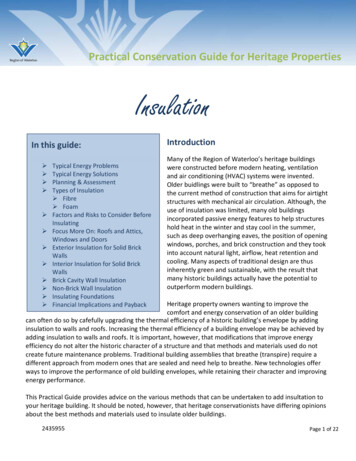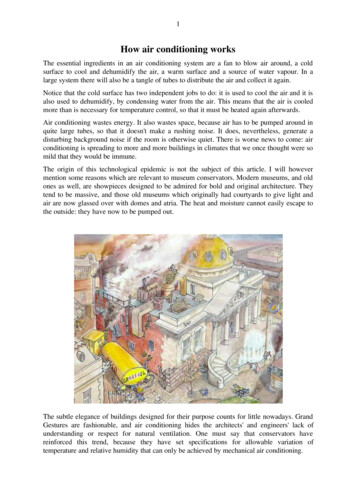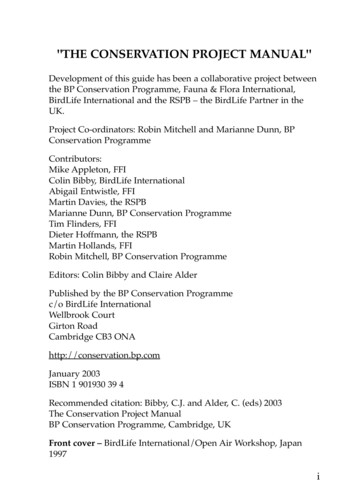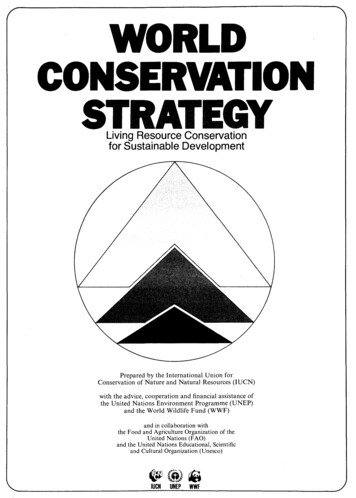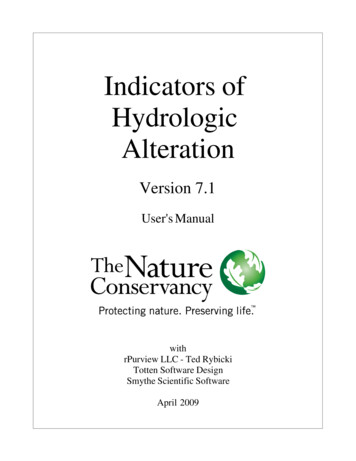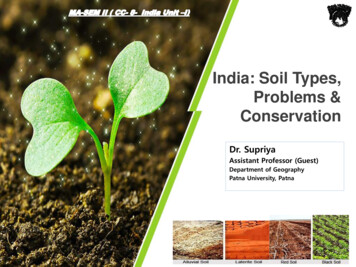
Transcription
India: Soil Types,Problems &ConservationDr. SupriyaAssistant Professor(Guest)INSERTTHE TITLEOF YOURPRESENTATION HEREDepartmentof GeographyPatna University, PatnaALLPPT.com Free PowerPoint Templates, Diagrams and Charts
CONTENTS Introduction Classification of Soils Major Soil Groups of India 1. Alluvial Soils 2. Black Soils 3. Red Soil 4. Laterite soil: 5.Desert soil: 6. Mountain soil 7. Alkaline and Saline Soils 8. Peaty Soils Problems of Indian soils Effect of soil erosion Soil Conservation Methods of Soil Conservation Model questions References
IntroductionSoil is the uppermost part of the Earth’s crust. It is formed due to the weatheringof rock under the influence of climate, vegetation, relief and parent rock.India is a country of vast dimensions with varied conditions of geology, relief, climate and vegetation. Therefore, India has a large variety of soil groups, distinctly different from one another. Different criteria have been applied to classify Indian soils:-geology, relief, fertility, chemical composition and physical structure, etc. Theformation of the soil in a particular climate is so perfect that each climate type andits own soilSoil ingredients: Soil being an important natural resources has many factors affecting its formation and they are:a) The parent rocks or material whose brake down gives regolith.b) Topography particularly the slope aspects i.e., whether it is steep, gentle or undulating as this will determine whether the soil is going to be thick or thin, whetherprone to erosion etcc) Climate being one of the most important factor acts through moisture, temperature andwindconditionsd) The type of vegetation found in the particular region has over-whelming responsibility for the coloration and the structure of the soil.
Classification of soilAny classification based on any one of the aforesaid criteria has its own inherent drawback. Even the most competent pedologist would find it difficult to present an accurate, complete, comprehensive and generalised account of the Indian soils.During the ‘British rule in India, a vast body of fascinating accounts had emerged indistrict gazetteers and official reports. These accounts were generally directed towards the assessment of differential soil fertility and land revenue collection, but did not attempt classification of soil types in the country.In 1957, The National Atlas Organisation (Kolkata) published a soil map of India inwhich Indian soils were classified into 6 major groups and 11 broad types.Geologically, Indian soils can broadly be divided into two main types: (a) Soils of peninsular India and (b) Soils of extra-peninsular India.The soils of Peninsular India are those which have been formed by the deomposition of rocks in situ, i.e. directly from the underlying rocks. They are transported and redeposited to a limited extent and are known as sedentary soils.On the other hand, the soils of the Extra-Peninsula are formed due to the depositional work of rivers and wind. They are mainly found in the river valleys and deltas. They are very deep and constitute some of the most fertile tracts of the country. They are often referred to as transported or azonal soils.
Classification of soil .The Irrigation Atlas of India (1972) andSpate’s India, Pakistan and Ceylon (1976)utilised the 7th approximation soil classification developed by the U.S. Departmentof Agriculture (USDA).The 7th approximation defines soil classes strictly in terms of their morphology and composition as produced by a set of natural and human forces. The classification is determined by quantifiable criteria. Inceptisols, Vertisols, Alfisols, Oxisols, Histosols, Ultisols, Podsols,mollisols, Entisols, Aridosols And Spodosols.
Major Soil Groups of IndiaThe Indian Council of Agricultural Research (ICAR) set up an All India SoilSurvey Committee in 1963 which divided the Indian soils into eight major groups, Later on ICAR divided in India in following Groups:(1) Alluvial soils,(2) Black soils,(3) Red soils,(4) Laterite and Lateritic soils,(5) Forest and Mountain soils,(6) Arid and Desert soils,(7) Saline and Alkaline soils and(8) Peaty and Marshy soilsThis is a very logical classification ofIndian soils and has gained wideacceptance.
1. Alluvial SoilsAlluvial soils are by far the largest and the most important soil group of India.Covering about 15 lakh sq km or about 45.6 per cent of the total land area of thecountry. These soils contribute the largest share of our agricultural wealth and support the bulk of India’s population.Being one of the most important and fertile soils of India they support growth of wide variety of crops such as Rice, wheat, sugarcane, cotton, jute, potatoand vegetables, but they are deficient in nitrogen, phosphorous and Humus.Alluvium are finer particles of rock materials carried in suspension and later deposited by the river in its bed and bank. The soils which is composed of alluvium is called alluvial soil.Most of the alluvial soils are derived from the sediments deposited by riversas in the Indo-Gangetic plain although some alluvial soils in the coastal areashave been formed by the sea waves. Thus the parent material of these soils isall of transported origin.The flood plains of Satluj-Ganga and Bhrahmaputra from Punjab to Assam, thevalleys and plains of river Narmada, Tapti, Mahanadi, Godhavari, Krishna and Cauvery covering about 23.40% of the total soil cover in India.
Occurrence & Types of Alluvial SoilThe widest occurrence of the alluvial soils is in the Great Indo-GangeticPlain starting from Punjab in the west to West Bengal and Assam in the east.They also occur in deltas of the Mahanadi, the Godavari, the Krishna andthe Cauvery, where they are called Deltaic alluvium.Along the coast they are known as Coastal alluvium. Some alluvial soilsare found in the Narmada and Tapi valleys. Northern parts of Gujaratalsohave some cover of alluvial soils.Geologically, the alluvium of the Great plain of India is divided intonewer or younger Khadar and older bhangar soils.The Khadar soils are found in the low areas of valley bottom which areflooded almost every year. They are pale brown, sandy clays and loams, more dry and leached, less calcareous and carbonaceous i.e. Theyare less kankary.The Bhangar, on the other hand, is found on the higher reaches about 30metres above the flood level. It is of a more clayey composition, generallydark coloured. A few metres below the surface of the bhangar are beds oflime nodules known as kankar
Along the Shiwalik foothills, there are alluvial fans having coarse, oftenpebbly soils. This zone is called bhabar. To the south of the bhabar is along narrow strip of swampy lowland with silty soils. It covers an areaof 56,600 sq km and is called tarai.The tarai soils are rich in nitrogen and organic matter but aredeficient in phosphate. These soils are generally covered by tall grasses andforests but are suitable for a number of crops such as wheat, rice, sugarcane,jute and soyabean under reclaimed conditions.
2. Black SoilsThe Black soil are so called because of their black colouration and derived from the Basalt rock under semi-arid conditions. It is also known as ‘Regur’ (from the Telugu word Reguda) or black cotton soil as it is best suited for cotton cultivation.In India black soil are largely found over Deccan trap region of the states ofMaharshtra, Madhya Pradesh, parts of Andhra Pradesh, Northern part of Karnataka,Gujarat, parts of Tamil Nadu and Rajasthan.Several theories have been put forward regarding the origin of this group of soilsbut most pedologists believe that these soils have been formed due to the solidificatinof lava spread over large areas during volcanic activity in the Deccan Plateau, in Triassic Period.Most of the black soils are derived from two types of parental rocks, the Deccan andthe Rajmahal trap, and ferruginous gneisses and schists occurring in Tamil Nadu.The former are sufficiently deep while the later are generally shallow.Krebs holds that the regur is essentially a mature soil which has been produced byrelief and climate, rather than by a particular type of rock. According to him, this soiloccurs where the annual rainfall is between 50 to 80 cm and the number of rainydays range from 30 to 50. The occurrence of this soil in the west deccan where therainfall is about 100 cm and the number of rainy days more than 50, is considered byhim to be an exception.
2. Black Soils .In some parts of Gujarat and Tamil Nadu, the origin of black cotton soils is ascribed to old lagoons in which the rivers deposited the materials brought down from the interior of Peninsula covered with lava.Geographically, black soils are spread over 5.46 lakh sq km (i.e. 16.6 per cent of the totalgeographical area of the country) encompassed between 15 N to 25 N latitudes and 72 E to 82 E longitudes. This is the region of high temperature and low rainfall. It is, therefore, asoil group of the dry and hot regions of the Peninsula. These soils are mainly found in Maharashtra, Madhya Pradesh, parts of Karnataka, Andhra Pradesh, Gujarat and Tamil Nadu.The black colour of these soils has been attributed by some scientists to the presence of asmall proportion of titaniferous magnetite or even to iron and black constituents of the parent rock. The black colour of this soil may even be derived from crystalline schists and basic gneisses such as in Tamil Nadu and parts of Andhra Pradesh. Various tints of the black colour such as deep black, medium black, shallow black or even a mixture of red and blackmay be found in this group of soils.The black soil is very retentive of moisture. It swells greatly and becomes sticky when wetin rainy season. Under such conditions, it is almost impossible to work on such soil because the plough gets stuck in the mud.However, in the hot dry season, the moisture evaporates, the soil shrinks and is seamedwith broad and deep cracks, often 10 to 15 cm wide and upto a metre deep. This permits oxygenation of the soil to sufficient depths and the soil has extraordinary fertility.
2. Black Soils .Remarkably “self-ploughed” by loosened particles fallen from the ground into the cracks, the soil “swallows” itself and retains soil moisture. This soil has been used for growing a variety of crops for centuries without adding fertilizers and manures, or evenfallowing with little or no evidence of exhaustion.A typical black soil is highly argillaceous with a large clay factor, 62 per cent or more, without gravel or coarse sand. It also contains 10 per cent of alumina, 9-10 per centof iron oxide and 6-8 percent of lime and magnesium carbonates. Potash is variable (less than 0.5 per cent) and phosphates, nitrogen and humus are low. The structure is cloddish but occasionally friable.In all regur soils in general, and in those derived from ferromagnesian schists in particular, there is a layer rich in kankar nodules formed by segregation of calcium carbonate at lower depths. As a general rule, black soils of uplands are of low fertility but they are darker, deeper and richer in the valleys.Because of their high fertility and retentivity of moisture, the black soils are widelyused for producing several important crops. Some of the major crops grown on the black soils are cotton, wheat, jowar, linseed, Virginia tobacco, castor, sunflower and millets. Rice and sugarcane are equally important where irrigation facilities are available.Large varieties of vegetables and fruits are also successfully grown on the black soils.
3. Red SoilRich in Iron Suitable for wheat and riceThese are generally reddish to brownish in color obtained from weathering of granites, gneisses, and crystalline rocks and grade from poor, thin and light colored soils on the uplands to that of fertile deep dark color soils of plains and valley.Red soils in India occupying 29.08% of the total soil cover of India extending extensively over parts of Tamil Nadu, Southern Karnataka , South-East Maharashtra, partsof Madhya Pradesh, Goa, Kerala, Orissa, Bihar, West Bengal, Uttar Pradesh, EasternParts of Rajasthan, Assam, Manipur, Tripura, Meghalaya and Nagaland.These soils are ideal for cultivation of Ragi, Ground-nuts, millets, Tobacco and potato. They are rich in Iron, containing small amount of Humus as they about retain moisture and are slightly acidic with poor quantity of phosphorous, nitrogen and organic contents. Though they can be used for variety of crop cultivation provided the fields are having good irrigation facilities.Red to yellow in color due to coatings of ferric oxides on the soil particles. Texture of these soils is highly variable from loam to clayey loam texture. They are poor in nitrogen, phosphorous and humus there by soil depth varies from shallow to very deep innature.
4. Laterite soilLaterite is a formation that is only found in tropical countries like India with alternative wet and dry climatic conditions. The heavy rainfall conditions and high temperature makes the soil rich in oxides of Iron and Aluminum depleting in completely fromSilica. The remnants of such oxides are known as laterites which are characterized bycompact to vesicular structure occupying 4.30% of India’s soil cover.They are mainly found on the summits of Western Ghats and Eastern Ghats along with Vindhyas and Satpura’s found in States of Karnataka, Kerala, Madhya Pradesh, Maharashtra, Orissa, Assam and Tamil Nadu.Since they are very poor in calcium and magnesium and are well drained and porous. They are useful for both rice cultivation as well as plantation crops like cashew, rubber, tea and coffee.They are acidic in elevated areas and poor in retaining moisture but essentially heavy loam to clayey on the plains.
5.Desert soilThe arid and the desert soil are found in semi-arid and arid condtional regions of India,namely the western Rajasthan, the Southern Haryana, and South-West Punjab. These are area lying between
Soil is the uppermost part of the Earth’s crust. It is formed due to the weathering of rock under the influence of climate, vegetation, relief and parent rock. India is a country of vast dimensions with varied conditions of geology, relief, cli mate and vegetation. Therefore, India has a

